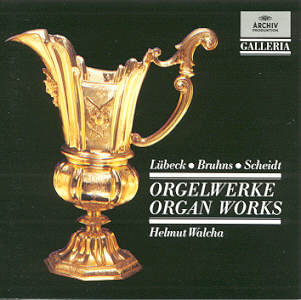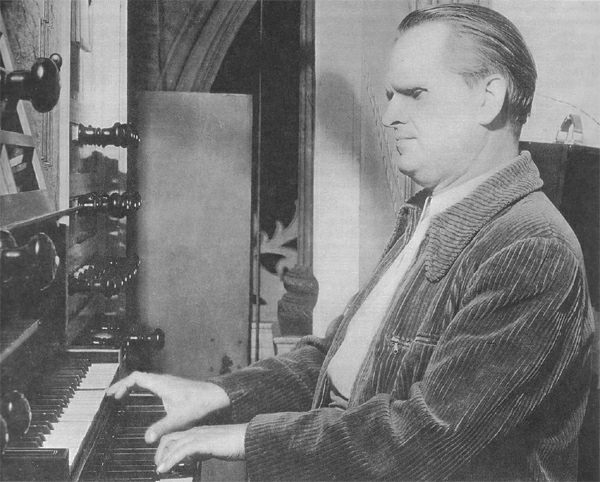Helmut Walcha(27th Oct. 1907 ~ 11th Aug. 1991)
< Insight instead of Sight >
Curriculum Vitae
 If you must memorize
all of the Bach's works, perhaps you will think you'd
rather die. But you will be
very surprised that the man who memorize all of the
Bach's works for organ and cembalo is perfectly blind,
and that he began it even after his blindness, which
spent about 15 years. The hero who completed what an
ordinary person cannot even imagine, and who said "The disease which cut me off
permanently from the visible world also opened up and
smoothed for me the way to inner perception.", was Helmut Walcha.
If you must memorize
all of the Bach's works, perhaps you will think you'd
rather die. But you will be
very surprised that the man who memorize all of the
Bach's works for organ and cembalo is perfectly blind,
and that he began it even after his blindness, which
spent about 15 years. The hero who completed what an
ordinary person cannot even imagine, and who said "The disease which cut me off
permanently from the visible world also opened up and
smoothed for me the way to inner perception.", was Helmut Walcha.
Helmut
was born on 27th December 1907, in Leipzig. His father
Emil was the head of a post office, and his mother was
named Anna Ficken. He had himself lost much of the vision
by the aftereffects of the smallpox vaccine at 1908, but
not all the sights as his parents soon knew it and
entered elementary school at six. He liked music by
virtue of his parents, and was taught the score-reading
by sister. By accident, he was moved by Bach's F major
invention and later interested in organ, so practised it
the church near home. His parents considered that he had
to enter music conservatory, but Helmut preferred only
playing.
When Helmut was twelve,
Feintheizen(?) who was the bassist of the Gewandhaus
Orchestra gave him the chance of the meeting with
legendary Arthur Nikisch(1855~1922) after he was
impressed by Helmut's playing. It is said that Helmut
played an improvisation after German folktone at the
meeting. Nikisch knew Helmut's gifts, recommending normal
musical training. Feintheizen taught Helmut the piano for
a year. But gradually Helmut's sight was deprived.
Chronic keratitis threatened his weak sight, and
operation totally failed. Therefore, Helmut perfectly
lost the light after sixteen(1923).
In
1922, he entered Leipzig Conservatory and was taught by Günther Ramin(1898~1956), who was famous
for the authorities of Bach. Later he succeeded the
Thomas Kantor after Karl Straube(his teacher) in 1940,
who gave the premier of the Art of Fugue. Ramin
thoroughly cultivated him, and Helmut greatly progressed
at piano, organ, and musical theory.
He gave the first recital at St. Andre
Church, which was well accepted. He became vice-organist
of Thomaskirche as Ramin's assistant in 1926, and
graduated and passed qualifying exam for organist in
Leipzig Conservatory summa cum laude next year.
Same year he came into chamber music research center in
Leipzig, and elected organist of the Peace Church in
Frankfurt in 1929. His Frankfurt ages thus began. He was
elected organ faculty Frankfurt Hochschule fur Musik in
1933. This school became national in 1938, and he
professor of Church Music Department. He married Ursula
Koch in the next year, when he made Bach series in
Frankfurt and gave concerts for a week every year. At the
end of WWII he temporarily stopped musical activities,
but restarted concert appearances in 1946. He took the
post of Dreikönigskirche(Three King's Church)
in Frankfurt. In 1947, the first newly made organ after
WWII was installed at the auditorium of Frankfurt
University by his effort. He played(and improvised) organ
each week at Dreikönigskirche, and gave
lectures on Bach's 165 organ works with playing them at
Frankfurt University. His good activities made Frankfurt central position of Bach
playing.
In 1947, he recorded Bach's works with the
small organ of St. Jakobi Church in Lübeck at Archiv
Produktion. His recordings by EMI and Archiv Produktion
increased his fame all over the world. He appeared Bach
bicentenary festival at Göttingen and taught apprentice
from the world. Frankfurt am Main rewarded him by Goethe
medal by memory of his great contribution to music. He
was revered as the master of Bach before he resigned in
1977 because of the bad health, and finished his
respectable life on 11th Aug. 1991.
 His main repertoires were Baroque era,
including Sweelink, Buxtehude, Pachelbel, J.S.Bach, and
Händel, all of which he learned after becoming blind. Of
course he had to memorize all. When he did so, two women
helped him; mother before wedding and wife(Ursula) after
wedding. They played one by one of the each voice by piano, then Helmut memorize the voices
and 'synthesize all of the voice parts in his head'. He
made up his mind to memorize all the works of Bach at 25
years old, which he took 15 years to finish the job. From
this thorough practice(is there any better method for
landscaping Bach's polyphonic structure?), trained
technique, and long experience rooted his stylistic
music, with masterly nobility (and stubborness). Strict
tempi and rhythm and well-considered beautiful
registration teach us manly facet of Bach's organ works.
As he grew older, his music warmer, more delicate, and
more beautiful. I wish he had not resigned at (only!) 70
years old.
His main repertoires were Baroque era,
including Sweelink, Buxtehude, Pachelbel, J.S.Bach, and
Händel, all of which he learned after becoming blind. Of
course he had to memorize all. When he did so, two women
helped him; mother before wedding and wife(Ursula) after
wedding. They played one by one of the each voice by piano, then Helmut memorize the voices
and 'synthesize all of the voice parts in his head'. He
made up his mind to memorize all the works of Bach at 25
years old, which he took 15 years to finish the job. From
this thorough practice(is there any better method for
landscaping Bach's polyphonic structure?), trained
technique, and long experience rooted his stylistic
music, with masterly nobility (and stubborness). Strict
tempi and rhythm and well-considered beautiful
registration teach us manly facet of Bach's organ works.
As he grew older, his music warmer, more delicate, and
more beautiful. I wish he had not resigned at (only!) 70
years old.
There
are many of his recordings
in DG and
EMI, total about 50 items by CD. Most of all, the supreme
is the second
complete recording of Bach's organ works(Archiv). This recording is monumental in all the
Bach recordings. I cannot forget the beautiful lucidity
of chorale preludes, and (toccata/prelude/fantasy and)
fugues are proud of the perfect construction of music and
technique. His last record 'Orgelmeister vor Bach(Organ masters before
Bach)' is also good(Archiv). He
gave exquisite registration in Pachelbel, Buxtehude,
Böhm, etc. and warmer musical line than younger years.
In cembalo works, EMI recorded most of the Bach's
representative works in 1958~62. He used modern model(Ammer), outstanding
colorful registration in spite of rather dark tone. In
special, English suites, Partitas, and Golberg variations
are very good. In 1970s, he re-recorded the Well-Tempered
Clavier with historic model at Archiv Produktion, which
is said to be very beautiful(transferred to CD by
Japanese and French DG). Only one chamber music recording
is complete set of violin sonata with Szeryng(Philips, by
historic model), and it's also well refined in ensemble.
 |
 |
| 5 Playing Saint-Pierre-le-Jeune organ | 5 In front of the organ in Saint-Pierre-le-Jeune Church |
 |
| 5 Playing the Great organ in Saint-Laurens Church, Alkmaar, Netherland |
The Resources
- Main ; an appendix of Eumak-Donga(a Korean music magazine), my records.
- Biography ; mainly from Toshiba-EMI TOCE 6887~99(Bach's cembalo music)
- Photos ; Archiv 419 904-2(12CD), by Mr. Rodrigo de Sa-Nogueira Saraiva(playing Alkmaar organ)
(c) 2000~ , Youngrok LEE ; Link free, but please get my approval before you reuse, copy, or quote this materials.
Created ; 3rd Dec. 2000
Last Update ; 14th Mar. 2002